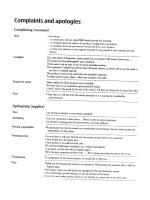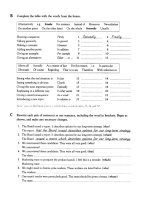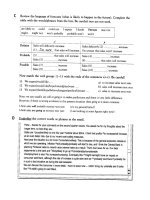paul gauguin
Bạn đang xem bản rút gọn của tài liệu. Xem và tải ngay bản đầy đủ của tài liệu tại đây (34.79 KB, 1 trang )
Paul Gauguin
I think Paul Gauguin had a very interesting life and I consider him one of the best artists of his
time. Although he had a very active life, he managed to express and record his feelings through
painting. In the following paragraphs I will explain Gauguin's life and give my opinion about his
life and his works of art.
Gauguin was born on June 7, 1848 in Paris. He was considered one of the leading painters of the
Postimpressionist period. In 1849 his journalist father's political activities forced the Gauguin
family into exile, and set off for Peru. His father died during the crossing from France. Gauguin's
mother, of Peruvian descent on her mother's side, and her two children moved in with a great
grand uncle and his family in Lima. At the age of 17 Gauguin joined the French merchant navy,
traveling around the world for six years. After the death of his mother in 1867, he settled down
with his wealthy guardian, Gustave Arosa, who had a large art collection that included works by
Delacroix. This period in time shaped Gauguin's interest in the arts. He started collecting
Impressionist paintings, and became an amateur painter.
Gauguin began his career as a stockbroker in Paris in 1872. He attended the Impressionist's first
exhibition in 1874, and was captivated by the impressionist style. He purchased works by Monet,
Pissarro, Renoir and others. His exposure to the Impressionists reinforced his desire to become a
painter. In 1883 the bank that employed Gauguin experienced financial difficulties, and he found
himself free to paint full-time. Much of his work during this period was influenced by the
Impressionists, especially Pissarro. In 1884 Gauguin went to paint at the artists haven of
Pont-Aven. Influenced during this period by van Gogh, Seurat, and Degas, he began to adopt his
own independent style. In 1887, Gauguin left France for Panama. For a short time he worked as a
laborer for the Panama Canal Company. He soon left Panama for Martinique, where he continued
his development as an artist. In 1888 he returned to Brittany. His experience in Martinique
broadened his vision and enabled him to develop original interpretations of scenes in Brittany. In
October, 1888 he traveled to Vincent van Gogh's home in Arles, France. His stay was both
traumatic and fruitful for both artists. Gauguin returned to Paris in December after Van Gogh's
"ear incident." Gauguin's break with the Impressionists came when he painted "Vision after the
Sermon," where he tried to depict the inner feelings of his subjects. This painting also marked the
start of a new painting style that came to be known as "Symbolism."
Although this period had been highly productive for Gauguin, he was deeply depressed and in
1891 abandoned his family to seek an idyllic life in the South Pacific Islands. He stayed briefly in
Tahiti's capital, Papeete, and then relocated to a remote part of the island. He lived in Tahiti from
1891 to 1893, and again from 1895 until his death. In Tahiti his painting style evolved to reflect
the Pacific Islands' primitive forms and brilliant colors. His striking images of Polynesian women
rank among the most beautiful paintings of the modern age. In 1904, Gauguin, dissipated by
drug-addiction, died of a heart attack on Hiva Oa Island in the Marquesas in French Polynesia.
I think that Gauguin always had an interest and talent in art, but began to put it
to action when he lost his job. He always had a good taste and knew how to appreciate art in
diverse ways. Although he was influenced by Impressionist artists of his time, he managed to paint
in his own independent style. Many of his painting were of things, people, and places in which he
had been in different times of his life. I think that one of his major influences was Vincent van
Gogh since they both had time to get to know each other better and share ideas. One of Gauguin's
masterpieces was "Vision after the Sermon," in which he showed the feelings of the subjects in the
paintings. With this painting he made a new painting style called Symbolism. Some of my
favorite paintings were towards the end of his life when he was in Tahiti and Polynesia. His
paintings were filled with bright colors and depicted the lifestyle in these islands. This is why I
think that Paul Gauguin has been one of the greatest artist.









